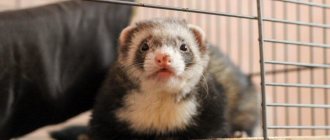Allergies are often the reason why people deny themselves pets, even if they really love animals.
There is also an opinion that allergies occur specifically to animal fur, although this is not the case. An allergic reaction occurs to an animal's saliva, sweat, dander, urine, fluff, feathers and other waste products. All of them contain a specific protein - a glycoprotein, which is an allergen. It gets on the animal's fur and, along with it, spreads throughout the house, bringing suffering to the allergic owner.
Therefore, it is worth remembering that there are no absolutely hypoallergenic animals, especially cats and dogs. There are only precautions that will help not harm the allergy sufferer. And also several breeds with the lowest health risks.
Of course, in addition to cats and dogs, you can also have representatives of other types of animals that are safe. But not everyone is inclined towards fish and reptiles. The following animals can become companions of such people:
Rodents
In addition to chinchillas, you can get other rodents. Syrian hamsters, hairless guinea pigs, and decorative pigs are perfect. The advantage of such animals is that they are mostly kept in a cage and do not scatter their fur around the house. The territory of their life activity is limited to a special house, so the risk of encountering an allergen is significantly reduced. Still, cleaning the cage of such an animal should be entrusted to another family member who does not suffer from allergies.
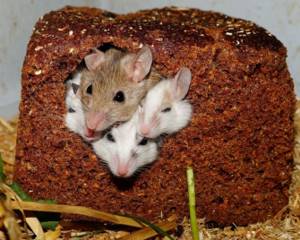
Amphibians
The cold nature of reptiles does not appeal to everyone. However, due to the absence of dandruff, fur and toxic secretions, cold-blooded animals are considered good friends with allergy sufferers and asthmatics.
Keeping lizards, turtles, snails and aquarium fish
will not affect the human immune system in any way. If, however, allergy symptoms do appear, then in most cases this will be associated with their habitat. For example, some species of turtles need moisture. And if you pay little attention to the cleanliness of the terrarium, mold may appear, which can provoke an allergic reaction.
Cats
As mentioned earlier, there are no absolutely non-allergenic animals. There are only those that produce fewer allergens. But if you don’t consider anyone other than cats as pets, then don’t believe in absolutely “harmless” breeds. The most common hypoallergenic cats are:

Sphinx
Hairless cat breeds, various types of sphinxes, have a specific appearance and require special care. These cats are believed to be very intelligent and love communication, and are also easy to train. Sphynx cats are very social, and some breeders claim that there is something dog-like in their behavior. Hairless cats are very sensitive to cold; you will have to maintain a certain temperature in the home so that it does not freeze. The Sphinx needs to be wiped every day with a damp cloth and not left in the bright rays of the sun, because it burns easily.
However, unlike their furry relatives, hairless cats sweat throughout their entire bodies. And allergies are mainly caused by the cat's sebaceous glands, which Sphynx cats have in abundance. Therefore, even though there will be no wool in the house, the sphinx will still be a distributor of that same protein, and in large quantities.
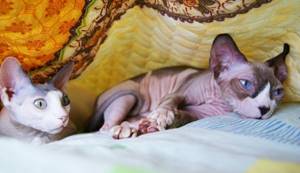
Cornish Rex
Cornish Rex cats have very short hair, but they do not have enough hair to absorb sebum like a normal cat. Therefore, these secretions can become a source of great concern for an allergy sufferer, as they contain the same protein. In principle, the same situation as with the Sphinx. But if you are allergic to wool, which is extremely rare, then these breeds will become excellent companions for such allergy sufferers.
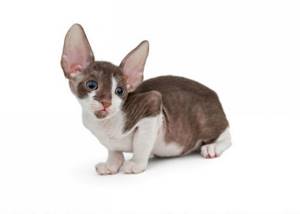
Photo: cattime.com
Devon rex
But in the saliva and sweat of Devon Rex glycoprotein is maximally reduced. All Devon Rex cats have a sparse coat; hair rarely falls out, which means there is less spread of glycoprotein throughout the house.
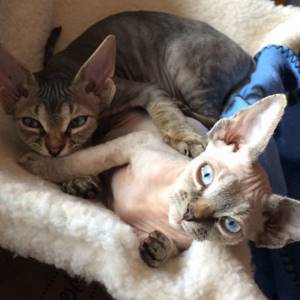
Photo: en.wikipedia.org/wiki/Devon_Rex
Siberian cat
Siberian cat breed. Despite their thick and long hair, these cats are hypoallergenic. Wool reliably protects the penetration of glycoprotein from the sebaceous glands onto the surface of the coat, and the saliva of Siberians has a very small concentration of it.
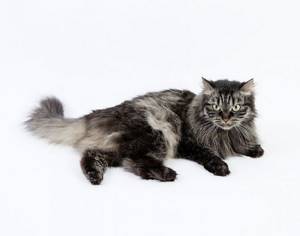
Photo: en.wikipedia.org/wiki/Siberian_cat
Russian blue
Cats are also hypoallergenic; their plush fur reduces the release of glycoprotein into the air. There is also very little of it in saliva.

In any case, before deciding to take a kitten home, an allergic person should spend at least a day in its company, no matter what breed it is. The following observations will also help:
- cats produce more allergens than cats;
- castrated animals are less allergic than non-castrated animals;
- kittens cause less allergic reaction than adult animals;
- Dark colored cats are four times more likely to cause sneezing, wheezing and allergic symptoms than light colored cats.
If you have allergies and decide to get a cat, you should establish the following rules in your home to reduce symptoms:
- Entrust all cat care to another family member, including cleaning the litter box, bathing the cat, trimming nails, etc.
- It is better to choose games without direct contact, using toys: ropes, balls and anything that your imagination allows. Such games are more popular with animals, develop them, and protect you from unwanted consequences.
- It’s still not possible to avoid touching the cat; you will definitely want to stroke and caress it. Therefore, after contact with an animal, be sure to wash your hands, and before that, do not touch your face or eyes.
- Wash your cat, rinsing its fur well. Since the cat's face contains the most glycoprotein, wash it carefully.
- Spay/neuter your cat.
- Wash your clothes often. Try not to use woolen items, giving preference to cotton ones.
- Wet clean your home with hot water as often as possible.
- Avoid heavy curtains, they are a trap for allergens and dust.
- You should not let your cat into the bedroom or bathroom; try to limit access to your clothes.
- Give your cat her own sleeping place.
- Try to reduce other allergens in the home, such as smoke, dust, mold, scented candles, chemicals, pollen, etc. The combination of different allergens causes more severe allergic reactions and asthma.
- Place the cat litter box in a well-ventilated place and change the litter often.
- Use good air purifiers.
- Talk to your doctor about treatment options or taking antiallergic medications.
Hypoallergenic animals
Hypoallergenic pets for the home are an excellent alternative for people with allergies to pet fur and excretions. For each person you can choose an option to your liking. It is not necessary to have a hairless animal; there are fluffy breeds for allergy sufferers.
Cold Blooded
Amphibians that are not allergic to are suitable for home keeping. However, you will have to take care of the conditions of detention. Possible options:
- Chameleon. Visually, it looks like a lizard; they love to hunt insects and are friendly towards their owners. This is a good option for allergy sufferers, since chameleon secretions do not contain dangerous proteins. However, you will have to take care of the place of detention and food.
- Aquarium fish. They have a wide variety of breeds and colors. You can't play with them or hold them in your hands. But watching and caring for such pets is a great pleasure. You will need an aquarium and a fish compressor.
- Gecko. Another species of lizard with a very interesting and bright color. Children will love them and are easy to care for. These pets are friendly and easy to get along with. Their favorite delicacy is cockroaches.
- Achatina. Large African snails. They barely fit entirely into the palm of an adult. Pets are not fussy about food and maintenance. They eat grass, cabbage, fruits and vegetables.

Achatina - a giant house snail
Cold-blooded animals are not everyone's cup of tea. Many people prefer to have a cat or dog as their best friend. Exotic pets can be more interesting than standard options.
The most common hairless breeds
What hairless animals are you not allergic to? This question often interests parents of children with allergies. After all, kids dream of a faithful friend in the house. There are several suitable hairless breeds:
- Sphinxes. The most popular breed of hairless cats. Takes first place in the ranking of hypoallergenic animals (see “Hypoallergenic cats - myth or reality?”). Due to the absence of fur, allergies occur much less frequently. However, they have a light, safe undercoat. These cats require special care and frequent washing.
- Peterblood. In 1996, scientists developed this breed of hairless cats by crossing the Sphynx and the Oriental cat. A distinctive feature of this animal is devotion and love for its owner. These cats sweat a lot and need to be washed twice a week.
- Chinese Crested. Small dogs are hairless and fluffy. For allergy sufferers, choose hairless pets. They still have long hair on their ears, ends of their paws and tail. However, this will not cause problems.
- Skinny and Baldwin. Hairless breeds of guinea pigs are suitable for those who do not want to have a large pet in the house. They are very active and eat vegetables and fruits. Lack of fur will not cause problems for an allergic child.

Is the Chinese Crested breed safe for people with allergies?
Don't forget that hairless animals also secrete dangerous proteins through their skin, saliva and feces, but to a lesser extent than furry ones. They need to be washed frequently and ensure proper nutrition.
Weak-shedding rocks
Are there low-shedding, hypoallergenic pets? This makes it possible for allergy sufferers to have a favorite “fluffy” in their home. There are many more such breeds than it seems.
Cats
It’s easy to choose an animal for a child with allergies. They will like any representative who can shower him with love and attention. Suitable cat breeds:
- Devon Rex. Short-haired cat breed. Animals that are not fussy to care for need to be washed 2 times a week because they produce a large amount of sweat. It is absorbed into the fur and spreads quickly. It is also necessary to keep your ears clean.
- Siberian is a fluffy cat breed. Despite their thick undercoat, they secrete a small amount of allergenic protein. They shed little and are friendly towards their owners.
- British. Cats have very beautiful yellow eyes and short gray-blue fur. They practically do not shed. Animals require a lot of attention, are picky eaters, and prefer to eat meat feed.
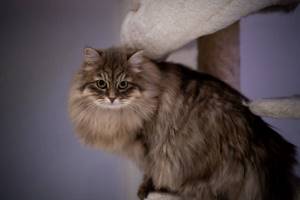
Siberian is one of the cat breeds that produces a minimum of allergenic protein
There are several options for cat lovers. Pets do not require serious care. However, do not forget about water procedures with shampoos in order to promptly remove allergens from the skin.
Video on the topic
Chinchilla in the house - pros and cons:
The most hypoallergenic dog breeds: list and photos
Names of breeds and photographs of hypoallergenic cats
What animal fur are the most severely allergic to in children and adults?
Brands of hypoallergenic cosmetics for women, men and children

Do people with allergies need an air purifier and how to choose the right option?
Why do allergies to silver and jewelry made from it occur if the metal itself is hypoallergenic?
the one who writes the article does not quite know where the allergy to cats comes from, an allergy. Not to fur, but to the protein that is contained in the saliva of cats, and even if she is bald, her saliva will still be on her. Parrots are very allergic; they have fine dandruff, which hangs around the house like flour. Our ENT specialist said that rabbits with their down are in first place in terms of allergies. So fish and that’s it.

However, the joy of owning a pet can be overshadowed by an allergy that you may not even know you have. What to do if you love animals, but cannot afford to keep them in your apartment due to unpleasant and dangerous allergy symptoms in you or your household?
People often report discomfort when being in the same room with a pet. Children suffer from animal allergies much more often than adults and their attacks are more severe.
For many years it was believed that it was wool that caused an allergy attack. Now it is known that the main enemy lies a little deeper - in feces, urine, sebaceous and sweat glands, microscopic skin cells and in the pet’s saliva. In most cases, the animal's coat only accumulates and transmits allergens.
Now let’s talk about two small misconceptions that you may encounter if you or your loved ones suffer from allergies, but cannot imagine your life without a pet.
All warm-blooded animals produce proteins that can cause allergic reactions in people with sensitive immune systems, meaning there are no completely hypoallergenic animals.
But there are animals with which even an allergy sufferer will feel comfortable if they provide proper care for their pet. Such animals are called hypoallergenic due to the lack of undercoat or due to the mild intoxication of the secretions. It is believed that animals without hair do not pose a serious danger to allergy sufferers, since they do not shed. Let's figure it out, is this really so?










